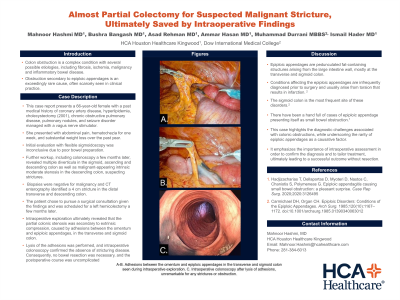Monday Poster Session
Category: Colon
P2031 - Almost Partial Colectomy for Suspected Malignant Stricture, Ultimately Saved by Intraoperative Findings
Monday, October 28, 2024
10:30 AM - 4:00 PM ET
Location: Exhibit Hall E

Has Audio

Mahnoor Hashmi, MD
HCA Kingwood
Kingwood, TX
Presenting Author(s)
Mahnoor Hashmi, MD1, Bushra Bangash, MD1, Asad Rehman, DO1, Ammar Hasan, MD1, Muhammad Durrani, MBBS2, Ismail Hader, MD1
1HCA Kingwood, Kingwood, TX; 2Dow University of Health Sciences, Kingwood, TX
Introduction: Colon obstruction is a complex condition with several possible etiologies, including fibrosis, ischemia, malignancy and inflammatory bowel disease. However, obstruction secondary to epiploic appendages is an exceedingly rare cause, often scarcely seen in clinical practice.
Case Description/Methods: This case report presents a 66-year-old female with a significant past medical history of coronary artery disease, hyperlipidemia, thyroid cancer status post-thyroidectomy (2000), cholecystectomy (2001), chronic obstructive pulmonary disease, pulmonary nodules, and seizure disorder managed with vagus nerve stimulator. She presented with abdominal pain, hematochezia for one week, and substantial weight loss over the past year. Initial evaluation with flexible sigmoidoscopy was inconclusive due to poor bowel preparation. Further workup, including colonoscopy a few months later, revealed multiple diverticula in the sigmoid, ascending and descending colon as well as malignant-appearing intrinsic moderate stenosis in the descending colon, suspecting strictures. Biopsies were negative for malignancy, and CT enterography identified a 4 cm stricture in the distal transverse and descending colon. The patient chose to pursue a surgical consultation given the findings and was scheduled for a left hemicolectomy a few months later.
Intraoperative exploration ultimately revealed that the partial colonic stenosis was secondary to extrinsic compression from adhesions between the omentum and epiploic appendages in the transverse and sigmoid colon. Lysis of the adhesions was performed, and intraoperative colonoscopy confirmed the absence of stricturing disease. Consequently, no bowel resection was necessary, and the postoperative course was uncomplicated.
Discussion: This case highlights the diagnostic challenges associated with colonic obstructions, while underscoring the rarity of epiploic appendages as a causative factor. Furthermore, it emphasizes the importance of intraoperative assessment in order to confirm the diagnosis and to tailor treatment, ultimately leading to a successful outcome without resection

Disclosures:
Mahnoor Hashmi, MD1, Bushra Bangash, MD1, Asad Rehman, DO1, Ammar Hasan, MD1, Muhammad Durrani, MBBS2, Ismail Hader, MD1. P2031 - Almost Partial Colectomy for Suspected Malignant Stricture, Ultimately Saved by Intraoperative Findings, ACG 2024 Annual Scientific Meeting Abstracts. Philadelphia, PA: American College of Gastroenterology.
1HCA Kingwood, Kingwood, TX; 2Dow University of Health Sciences, Kingwood, TX
Introduction: Colon obstruction is a complex condition with several possible etiologies, including fibrosis, ischemia, malignancy and inflammatory bowel disease. However, obstruction secondary to epiploic appendages is an exceedingly rare cause, often scarcely seen in clinical practice.
Case Description/Methods: This case report presents a 66-year-old female with a significant past medical history of coronary artery disease, hyperlipidemia, thyroid cancer status post-thyroidectomy (2000), cholecystectomy (2001), chronic obstructive pulmonary disease, pulmonary nodules, and seizure disorder managed with vagus nerve stimulator. She presented with abdominal pain, hematochezia for one week, and substantial weight loss over the past year. Initial evaluation with flexible sigmoidoscopy was inconclusive due to poor bowel preparation. Further workup, including colonoscopy a few months later, revealed multiple diverticula in the sigmoid, ascending and descending colon as well as malignant-appearing intrinsic moderate stenosis in the descending colon, suspecting strictures. Biopsies were negative for malignancy, and CT enterography identified a 4 cm stricture in the distal transverse and descending colon. The patient chose to pursue a surgical consultation given the findings and was scheduled for a left hemicolectomy a few months later.
Intraoperative exploration ultimately revealed that the partial colonic stenosis was secondary to extrinsic compression from adhesions between the omentum and epiploic appendages in the transverse and sigmoid colon. Lysis of the adhesions was performed, and intraoperative colonoscopy confirmed the absence of stricturing disease. Consequently, no bowel resection was necessary, and the postoperative course was uncomplicated.
Discussion: This case highlights the diagnostic challenges associated with colonic obstructions, while underscoring the rarity of epiploic appendages as a causative factor. Furthermore, it emphasizes the importance of intraoperative assessment in order to confirm the diagnosis and to tailor treatment, ultimately leading to a successful outcome without resection

Figure: A-B. Adhesions between the omentum and epiploic appendages in the transverse and sigmoid colon seen during intraoperative exploration.
C. Intraoperative colonoscopy after lysis of adhesions, unremarkable for any strictures or obstruction.
C. Intraoperative colonoscopy after lysis of adhesions, unremarkable for any strictures or obstruction.
Disclosures:
Mahnoor Hashmi indicated no relevant financial relationships.
Bushra Bangash indicated no relevant financial relationships.
Asad Rehman indicated no relevant financial relationships.
Ammar Hasan indicated no relevant financial relationships.
Muhammad Durrani indicated no relevant financial relationships.
Ismail Hader indicated no relevant financial relationships.
Mahnoor Hashmi, MD1, Bushra Bangash, MD1, Asad Rehman, DO1, Ammar Hasan, MD1, Muhammad Durrani, MBBS2, Ismail Hader, MD1. P2031 - Almost Partial Colectomy for Suspected Malignant Stricture, Ultimately Saved by Intraoperative Findings, ACG 2024 Annual Scientific Meeting Abstracts. Philadelphia, PA: American College of Gastroenterology.
